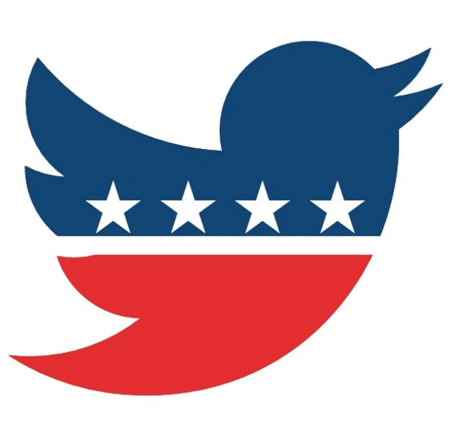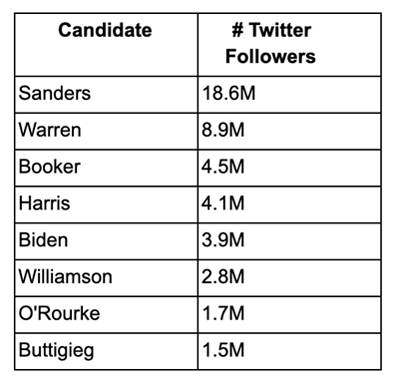Will Twitter decide the 2020 presidential election?
Is Mayor Pete Buttigieg really surging? Is Senator Elizabeth Warren really the new frontrunner? Can any of the Democratic candidates match Trump’s social media presence? Chief Strategy Officer Brad Berens examines the political Twitterverse.
By Brad Berens
Most Americans, regardless of party, will agree that Donald Trump has been an unusual President of the United States, including his use of Twitter.
 Between his personal Twitter account (@realDonaldTrump) with 66.3 million followers and the official presidential account (@POTUS) with 27 million followers, Trump has a potential 100 million people with whom he can directly connect at any time without the help of his press secretary and even without the press itself! (I say “potential” because we should presume duplication of followers between the two accounts.)
Between his personal Twitter account (@realDonaldTrump) with 66.3 million followers and the official presidential account (@POTUS) with 27 million followers, Trump has a potential 100 million people with whom he can directly connect at any time without the help of his press secretary and even without the press itself! (I say “potential” because we should presume duplication of followers between the two accounts.)
Never before has a president spoken so directly to the public, or so often. At the moment I’m writing this column, Trump has tweeted or retweeted 18 times today from his personal account across a variety of topics lofty (the successful raid against ISIS), political (the impeachment investigation), and surprising (Tiger Woods’ PGA Tour record). The @POTUS account retweeted Trump’s personal account fourteen times today.
Twitter was founded in 2006, during the second term of George W. Bush, who never did anything with the service while in office and hasn’t done much since (although he is a fan of Instagram). Barack Obama had an immense Twitter following as president (the @POTUS account launched in 2015), and even today (@BarackObama) he has a larger audience than Trump with just shy of 110 million followers. As president, it was Obama’s press team who most often posted to the presidential Twitter account.
Advertising people talk about P.O.E.M., which stands for Paid, Owned, and Earned Media. When the Trump re-election campaign buys an ad on Twitter (although why would they when 19 percent of all adult Twitter users follow him already?), that is paid media. When somebody retweets the president, that is earned media. Trump’s tweets are owned media: he controls the content utterly. Each tweet has the potential to be seen by 100 million people, which, again in ad-speak, means that it can earn 100 million potential “impressions.”
Amidst the controversy about Facebook’s unwillingness to take down political ads that contain false claims and concerns about Russia and China using social media to meddle in the next presidential election, it’s easy to lose sight of the immense owned media advantage Trump has because of both his massive Twitter following and his massive commitment to using it. And, since the press follows the president’s tweets obsessively, that adds even more earned media.
How do the democratic candidates for president stack up? Not well.
Of the 18 current Democratic candidates for president, only eight have a million or more Twitter followers:

The four senators (Sanders, Warren, Booker, and Harris) all have both personal and official Twitter accounts, so we should some presume duplication of followers, as we did with the president. The other four (Biden, Williamson, O’Rourke, and Buttigieg) each only have one Twitter account.
Together, the Twitter followings of all eight of these candidates add up to 46 million, which is less than half of the president’s number of followers.
If–and it’s a big if–it’s reasonable to take Twitter followers as a proxy for likely voters (see disclaimer below), then Senator Sanders is the clear Democratic frontrunner with more than twice the followers as Senator Warren in second place, and more than 12 times as many followers as the eighth place candidate, Mayor Pete Buttigieg.
These numbers are important because they complicate some of the recent narratives running wild in the media, like how Mayor Buttigieg is surging in popularity, or how Senator Sanders’ star is fading, or how Senator Warren has become the frontrunner, or whether former Vice President Biden has ever really been the frontrunner. The latter was true in conventional polling, but not in terms of Twitter presence.
___________________________________________________________________________
Between his personal Twitter account (@realDonaldTrump) with 66.3 million followers and the official presidential account (@POTUS) with 27 million followers, Trump has a potential 100 million people with whom he can directly connect at any time without the help of his press secretary and even without the press itself. Never before has a president spoken so directly to the public, or so often.
___________________________________________________________________________
But even if Sanders is the frontrunner for the Democratic nomination, he still has only 18.6% of the president’s number of followers. Moreover, today Senator Sanders tweeted 15 times from his personal account (@berniesanders and four times from his official account (@sensanders), but there was no retweeting among those accounts.
The math is simple.
On the day I’m writing this column, Senator Sanders tweeted 19 times to 18.6 million followers to earn 353 million potential impressions.
This same day, President Trump tweeted 32 times to 100 million followers to earn 3.2 billion potential impressions, which is more than nine times the earned media of Senator Sanders.
What should other candidates do?
For context, I reached out to my friend John Durham, CEO of Catalyst SF and formerly the president of Pericles Communications, the first firm to specialize in the intersection of politics and digital advertising back in 2003. Here’s what John had to say:
All the 2020 players, from the President to the cities and states across the country, will invest primarily in digital advertising as their main way to energize and activate their voters. Twitter is a megaphone for all of them. The best use of Twitter is for the already converted, as it will help them to be more active and engaged with the candidate. The candidate can chat with the converted in 140 characters in real time, all the time, and they don’t get pissed off at all. In fact, they want it. Trump is brilliant at Twitter and understands its importance. In contrast, most of the Democrats right now view Twitter as a “nice to have.” That has to change. Twitter is a “must have” communications tool–must! In an impersonal world, Twitter is intimate, shareable, and a critical tool for the converted who will do all they need to do in order to get people to vote!
The 18 Democratic candidates and the three Republicans possibly running against the incumbent for the GOP nomination (Sanford, Walsh, and Weld) should all follow President Trump’s lead and invest immense effort in building their followers and then tweeting to them relentlessly.
It’s reasonable to argue that Trump won the 2016 presidential election because none of the other candidates took seriously how he used Twitter to communicate directly with the public. While politicians and the press alike have been consumed with the president’s tweets ever since he won the election, they haven’t been able to turn this obsession into a strategy.
That could be a fatal mistake for any candidate, of any party, who wants to defeat Trump in 2020.
__________

Brad Berens is the Center’s Chief Strategy Officer. He is also principal at Big Digital Idea Consulting.
Disclaimer: I’m well aware that comparing numbers of Twitter followers is a simplistic metric that doesn’t take into account retweets by others, how associated Twitter users (like Mayor Pete Buttigieg’s husband Chasten with his 388,000 Twitter followers) might impact awareness, or how different topics and keywords will have different impacts on followers. I’m also aware that there are other social networking services (Facebook and Instagram, Snapchat, LinkedIn, TikTok) with immense user bases.
With all of that stipulated, Trump’s outsized Twitter presence is still something that challengers need to reckon with, particularly since Twitter is the favorite social networking service of the press. This is not likely to be a situation in which David beats Goliath.
See all columns from the Center.
October 30, 2019

